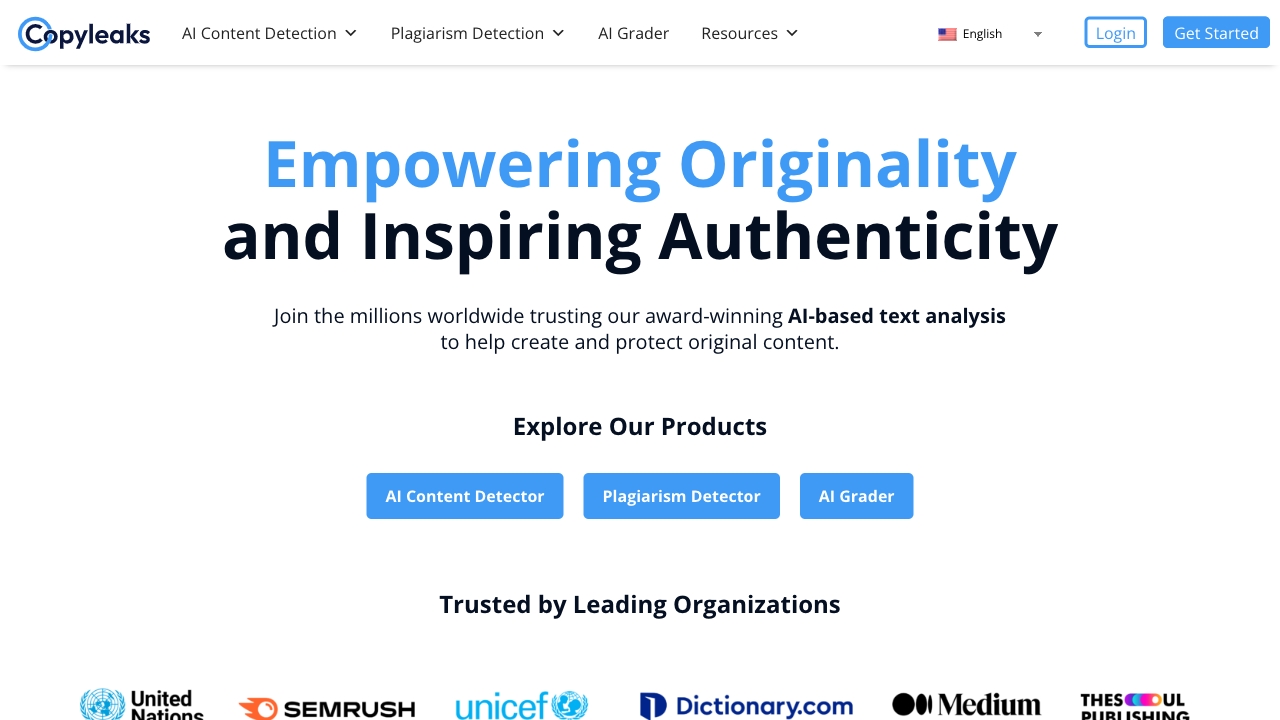- Home
- AI Writing Assistants
- Copyleaks

Copyleaks
Open Website-
Tool Introduction:Top TTS for Chrome, iOS, Android, Mac—AI voices, cloning, dubbing, AI video.
-
Inclusion Date:Oct 21, 2025
-
Social Media & Email:
Tool Information
What is Copyleaks AI
Copyleaks AI is an AI-powered content authenticity platform that detects plagiarism, AI-generated text, and paraphrasing across multiple languages. It verifies originality and helps confirm authorship by comparing submissions against web pages, academic sources, and private repositories. With detailed originality reports, similarity scores, and AI-content probability indicators, Copyleaks supports academic integrity, ethical AI use, and intellectual property protection. Institutions, enterprises, and individuals use it to maintain transparent, trustworthy writing workflows.
Copyleaks AI Main Features
- Plagiarism detection: Compare text against extensive online and academic sources to surface exact and near-duplicate matches with a clear similarity score.
- AI content detection: Identify likely AI-generated writing using linguistic signals and statistical patterns to support ethical AI policies.
- Paraphrase detection: Highlight reworded passages and patchwriting to reveal disguised overlaps with original sources.
- Multilingual support: Scan content in multiple languages, enabling global plagiarism checks and cross-language comparisons.
- Source mapping and citations: Trace matched segments back to original URLs or repositories and audit citation coverage.
- Originality reports: Receive visual reports with color-coded matches, confidence indicators, filters, and share/export options.
- API and integrations: Embed checks in LMS, CMS, and custom workflows via API for real-time or batch scanning.
- Policy controls: Configure sensitivity thresholds, exclude references or quotes, and apply organization-wide rules.
Who Should Use Copyleaks AI
Copyleaks AI suits educators, students, and researchers safeguarding academic integrity; publishers and editors ensuring editorial originality; marketing and SEO teams validating unique content; enterprises enforcing content governance and IP protection; legal and compliance teams verifying authorship; and e‑learning platforms that need scalable, integrated plagiarism and AI writing detection.
How to Use Copyleaks AI
- Create an account and set organizational policies (e.g., exclusion rules, sensitivity levels).
- Upload documents or paste text; choose supported file formats and languages.
- Select checks to run: plagiarism detection, AI content detection, and/or paraphrasing detection.
- Optionally integrate via API or LMS/CMS to automate submissions and batch scans.
- Start the scan and monitor progress from the dashboard.
- Review the originality report: matched sources, similarity score, AI probability indicators, and paraphrase highlights.
- Refine filters (exclude bibliography, quotes, or domains) and re-run if needed.
- Export or share the report and document remediation steps for compliance.
Copyleaks AI Industry Use Cases
Universities screen assignments and theses for plagiarism and AI-generated passages, supporting honor codes. Publishers verify manuscripts for originality and proper citation before release. Marketing teams validate blog posts and product copy to avoid duplication and maintain brand trust. Enterprises check policy documents and training materials for IP risks. E‑learning platforms integrate Copyleaks via API to auto-check submissions at scale, flagging paraphrased or AI-written content for instructor review.
Copyleaks AI Pricing
Copyleaks AI offers paid plans tailored for individuals, academic institutions, and enterprises, with options that may include subscription tiers and usage-based API billing. Availability of a free trial or demo can vary by plan. For current pricing, limits, and feature comparisons, consult the official Copyleaks website or sales team.
Copyleaks AI Pros and Cons
Pros:
- Robust plagiarism and AI writing detection with clear originality reports.
- Effective paraphrasing detection to uncover reworded overlaps.
- Multilingual support for global content checks.
- API and integration options for LMS/CMS and custom workflows.
- Configurable policies, thresholds, and exclusions to reduce noise.
- Actionable source mapping and citation auditing.
Cons:
- AI detection may yield false positives/negatives; human review remains essential.
- Costs can increase with high document volumes or API usage.
- Uploading sensitive documents may require strict data governance policies.
- Results quality can vary by language, domain, and source coverage.
Copyleaks AI FAQs
-
How does Copyleaks detect AI-generated content?
It analyzes linguistic patterns, token usage, and statistical signals, combining them with model-informed heuristics to estimate the likelihood that text was machine-generated.
-
Can Copyleaks detect paraphrased text?
Yes. It highlights reworded segments and patchwriting, mapping them back to potential source material for review.
-
Which languages are supported?
Copyleaks supports checks across multiple languages, enabling multilingual plagiarism and cross-language comparisons.
-
Does it integrate with learning or content platforms?
Yes. Organizations can use the API to integrate with LMS, CMS, and custom systems for automated, at-scale scanning.
-
What does the similarity score mean?
The similarity score reflects the percentage of text overlapping with detected sources; use it alongside the report’s context, citations, and exclusions for accurate interpretation.


